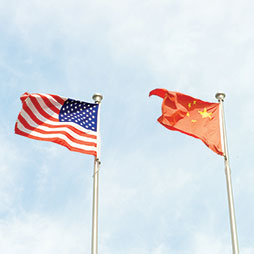An Opportunity to Use the Space Domain to Strengthen the U.S.-China Relationship
Brian Weeden (Secure World Foundation) discusses the U.S.-China relationship in space and provides recommendations for managing tensions and promoting positive engagement ahead of the presidential summit.
The U.S.-China relationship in space has the potential to be a stable foundation for a stronger overall relationship between the two countries. Space was arguably a stabilizing element in the relationship between the United States and Soviet Union during the Cold War by providing national capabilities to reduce tensions and an outlet for collaboration. Although the future of the U.S.-China relationship will be characterized by both competition and cooperation, taking concrete steps to stabilize relations in space can be part of the solution to avoiding the “Thucydides trap,” where an established power’s fear of a rising power leads to conflict.
The Role of Space in the U.S.-China Relationship
Space is a critical domain to the security of the United States. Space capabilities enable secure, hardened communications with nuclear forces, enable the verification and monitoring of arms control treaties, and provide valuable intelligence. Such capabilities are the foundation of the United States’ ability to defend its borders, project power to protect its allies and interests overseas, and defeat adversaries. The space domain, however, is currently experiencing significant changes that could affect the United States’ ability to maintain all these benefits in the future. A growing number of state and nonstate actors are involved in space, resulting in more than 1,200 active satellites in orbit and thousands more planned in the near future. Active satellites coexist in space along with hundreds of thousands of dead satellites, spent rocket stages, and other pieces of debris that are a legacy of six decades of space activities. As a result, the most useful and densely populated orbits are experiencing significant increases in physical and electromagnetic congestion and interference.
Amid this change, China is rapidly developing its capabilities across the entire spectrum of space activities. It has a robust and successful human spaceflight and exploration program that in many ways mirrors NASA’s successes in the 1960s and 1970s and is a similar source of national pride. Although it still has a long way to go, China is developing a range of space capabilities focused on national security that one day might be second only to those of the United States. Some of China’s new capabilities have created significant concern within the U.S. national security community, as they are aimed at countering or threatening the space capabilities of the United States and other countries.
The massive changes in the space domain and China’s growing capabilities have affected the U.S.-China relationship in space. There is growing mistrust between the two countries, fueled in part by their development and testing of dual-use technologies such as rendezvous and proximity operations and hypervelocity kinetic kill systems. This mistrust is compounded by a misalignment in political and strategic priorities: China is focused on developing and increasing its capabilities in the space domain, whereas the United States is focused on maintaining and assuring access to its space capabilities.
Recommendations for Managing Tensions and Promoting Positive Engagement
Despite these challenges and concerns, there are concrete steps that the United States and China can take to manage tensions and possibly even work toward positive engagement. In 2011, President Barack Obama and then Chinese president Hu Jintao issued a joint statement on strengthening U.S.-China relations during a visit by President Hu to the White House. As one of the steps outlined in the statement, the two presidents agreed to take specific actions to deepen dialogue and exchanges in the field of space and discuss opportunities for practical future cooperation.
President Xi Jinping’s upcoming visit presents an opportunity to build on the 2011 agreement and take steps toward these goals. The first step should be to have a substantive discussion on space security. President Obama should clearly communicate the importance that the United States places on assured access to space, U.S. concerns with recent Chinese counterspace testing, and the potential negative consequences of any aggressive acts in space. Both countries should exchange views on space policies, including their interpretations of how self-defense applies to satellites and hostile actions in space. Doing so can help avoid misunderstandings and misperceptions that could lead either country to unwittingly take actions that escalate a crisis.
Second, Presidents Obama and Xi should discuss specific ideas for cooperation in civil and scientific space activities and the use of space for peaceful applications on earth. Continuing to exclude China from civil space cooperation will not prevent it from developing its own capabilities; this approach will only ensure that China cooperates with other countries in space in a way that advances its own national interests and goals. Space weather, scientific research, exploration, capacity building for disaster response, and global environmental monitoring are all areas where the United States and China share joint interests and could collaborate with each other and other interested countries to help establish broader relationships outside the military realm.
In addition, the United States should take steps on its own to stabilize the relationship. First and foremost, it should get serious about making U.S. space capabilities more resilient. Increasing resilience would support deterrence by decreasing the benefits an adversary might hope to achieve and also help ensure that critical capabilities can survive should deterrence fail. While resilience has been a talking point for the last few years, the United States has made little progress toward achieving the goal. Radical change is thus needed in how Washington develops and organizes national security space capabilities. Moreover, the United States should embrace commercial services to diversify and augment governmental capabilities, while encouraging allies to develop their own space capabilities.
Second, the United States should continue to bolster the transparency of space activities by increasing the amount of space situational awareness (SSA) data available to satellite operators and the public. Greater transparency reinforces ongoing U.S. and international initiatives to promote responsible behavior in space and also helps mitigate the possibility for accidents or naturally caused events to spark or escalate tensions. Shifting responsibility for space safety to a civil agency that can share and cooperate more easily with the international community and working with the international community to develop more publicly available sources of SSA data outside the U.S. government are two steps that would enhance trust, improve data reliability, and reinforce norms of behavior.
The consequences of not addressing the current strategic instability in space are real. A future conflict in space between the United States and China would have devastating impacts on everyone who uses and relies on space. Both the United States and China have acknowledged the dangers of outright conflict and have pledged their interest in avoiding such an outcome. Taken together, the initial steps outlined here could help stabilize the U.S.-China strategic relationship in space, mitigate the threat of the worst-case scenario, and work toward a more positive outcome that benefits all.
Brian Weeden is the Technical Advisor for Secure World Foundation and a former U.S. Air Force Officer with sixteen years of professional experience in space operations and policy.



